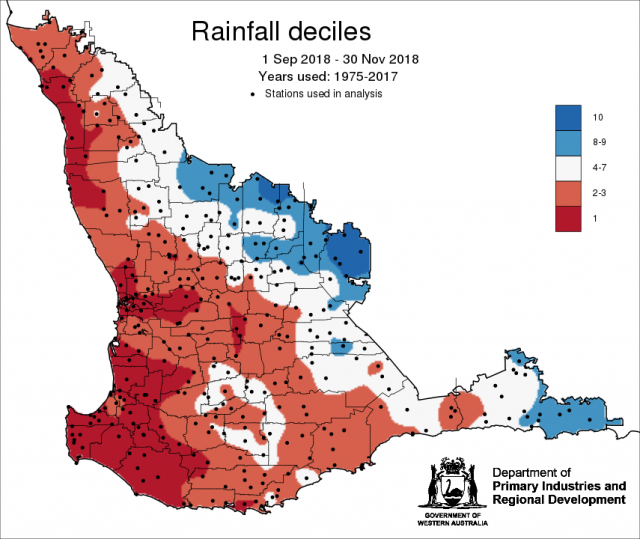Summary
The Department of Primary Industries and Regional Development’s (DPIRD) Statistical Seasonal Forecast (SSF) system is indicating generally a neutral, 40-60%, chance of exceeding median rainfall for summer, December 2018 to February 2019 for the South West Land Division (SWLD).
- The SSF is indicating for summer, December 2018 to February 2019, neutral (40-60%) chances of exceeding median rainfall for the majority of the grainbelt. Greater chances, 60-70% for the far northern grainbelt. The most probable decile range is decile 4-7 for most of the grainbelt. With decile 8-10 rainfall likley for parts of the northern and southern grainbelt. Predictive skill based on November conditions is mostly poor to good (50- 70% consistent).
- The Bureau of Meteorology’s current seasonal outlook is indicating roughly equal chances (40-50%) of exceeding or below median rainfall for summer, December 2018 to February 2019 for mostly of the SWLD, with small areas to the north showing a tendency towards below median rainfall (35-40%). Predictive skill is moderate to good (55-75% consistent).
- Temperature outlooks for summer, December 2018 to February 2019, from the Bureau indicate 60-80% chance of above average day-time maxima for the SWLD away from the coasts. Skill is moderate to good at 55-75% consistent. Minimum temperature outlooks indicate 60-75% chance of above average night-time minima for most of the SWLD except the northwestern areas with 50-60% chancewith skill mostly moderate to good at 55-75% consistent.
- November rainfall was below average in some parts of the northern and central grainbelt, above average in the eastern grainbelt and average elsewhere. Reports of heavy rainfall and hail in mid-November and early December, interfered with harvesting in some central and eastern areas. November maximum and minimum temperatures were below average to average.
Three Month Outlook for the south-west of Western Australia
Statistical Seasonal Forecasting (SSF)
DPIRD’s Statistical Seasonal Forecast (SSF) system uses historical relationships between global sea surface temperature and sea level pressure with rainfall in south-west Australia to produce forecasts of rainfall for the coming months. Users can click on any station indicated on the map for location-specific forecast information from the Seasonal Climate Information web page.
The SSF is indicating for summer, December 2018 to February 2019, neutral (40-60%) chances of exceeding median rainfall for the majority of the grainbelt. Greater chances, 60-70% for the far northern grainbelt. The most probable decile range is decile 4-7 for most of the grainbelt. With decile 8-10 rainfall likley for parts of the northern and southern grainbelt. Predictive skill based on November conditions is mostly poor to good (50- 70% consistent).
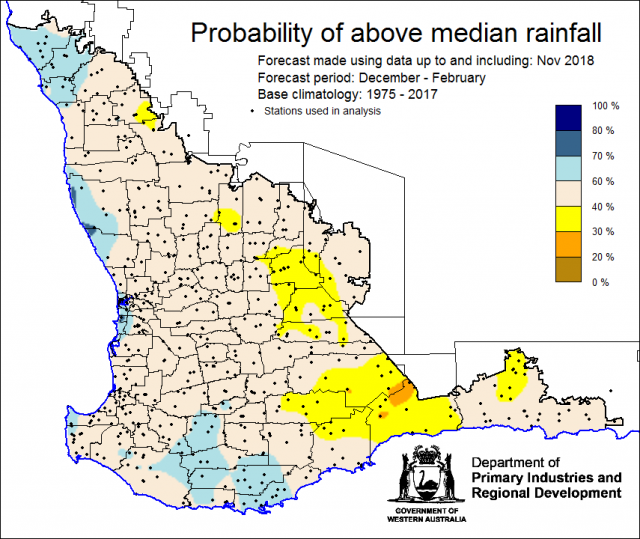
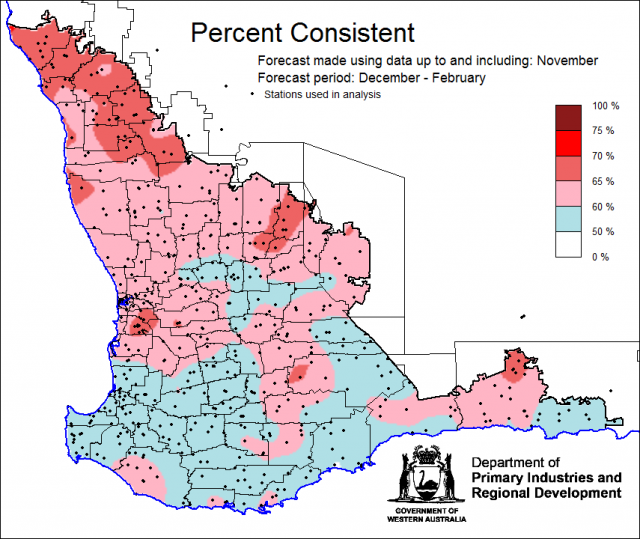
Bureau of Meteorology seasonal climate outlook
The Bureau of Meteorology's climate forecast system for monthly and seasonal climate outlooks is called the Australian Community Climate Earth-System Simulator – Seasonal (ACCESS–S). It is a dynamical (physics-based) forecast modelling system and is a collaboration between the Bureau of Meteorology and the UK Meteorological Office.
The Bureau of Meteorology’s current seasonal outlook is indicating a 35-50% chance of exceeding median rainfall for summer, December 2018 to February 2019 for the South West Land Division (SWLD). Predictive skill is moderate to good (55-75% consistent).
Temperature outlooks for summer, December 2018 to February 2019, from the Bureau indicate 60-80% chance of above average day-time maxima for the SWLD away from the coasts. Skill is moderate to good at 55-75% consistent. Minimum temperature outlooks indicate 60-75% chance of above average night-time minima for most of the SWLD except the northwestern areas with 50-60% chance, with skill mostly moderate to good at 55-75% consistent.
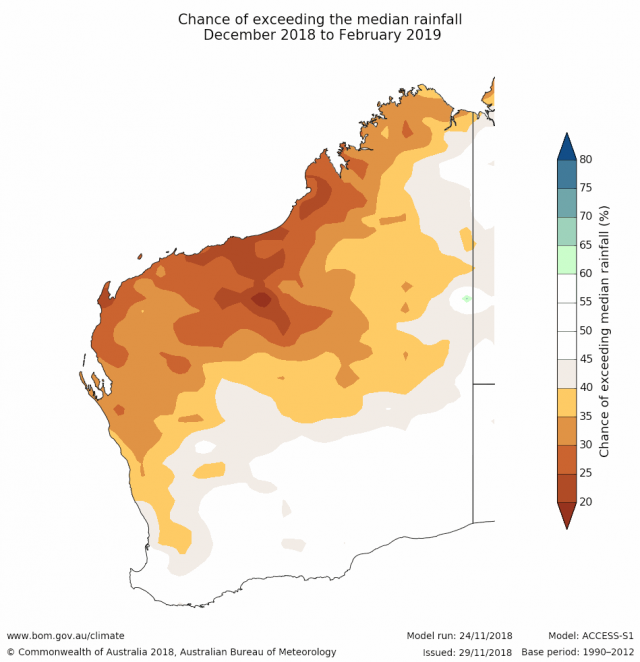
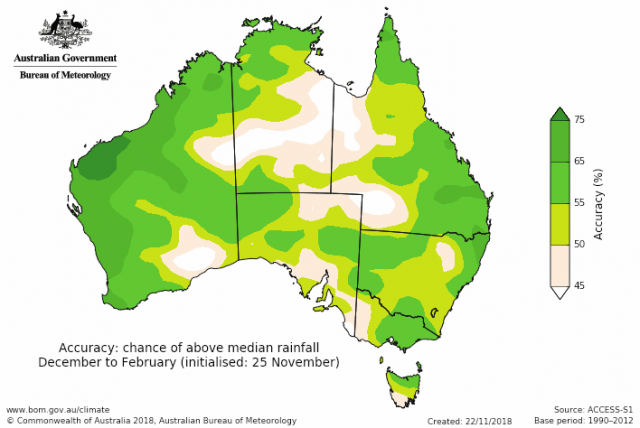
Recent climate
November rainfall was below average in some parts of the northern and central grainbelt, above in the eastern grainbelt and average elsewhere. Reports of heavy rainfall and hail in mid-November and early December, interfered with harvesting in some central and eastern areas. Fires in Dalwallinu from lighting strikes caused considerable damage. November maximum and minimum temperatures were below average to average.
For spring, September to November 2018 was below average for parts of the northern and southern grainbelt. Areas of the eastern and Esperance shire received above average rainfall from thunderstorms across the region that delivered localised heavy falls. Fires in Dalwallinu from lighting strikes caused considerable damage. In the September Seasonal Climate Outlook, the SSF indicated below median rainfall and the Bureau indicated below median rainfall for the western parts of the SWLD.
In November, the atmospheric pressure was above normal over most of Australia except the far southeast, contributing to the below average rainfall for the majority of the grainbelt and south-west corner in WA. The Indian Ocean sea surface temperatures continue to be cooler than average to Australia's northwest. This can lead to reduced rainfall, as less atmospheric moisture is available for rain-bearing weather systems.
The Southern Annular Mode (SAM), also known as the Antarctic Oscillation (AAO), describes the north–south movement of the westerly wind belt that circles Antarctica, dominating the middle to higher latitudes of the southern hemisphere. SAM is currently positive. In a positive SAM event, the belt of strong westerly winds contracts towards Antarctica, resulting in weaker than normal westerly winds and higher pressures over southern Australia, restricting the penetration of cold fronts inland. The National Oceanic and Atmospheric Administration (NOAA) suggests that SAM is likely to remain positive until mid-December.
The positive IOD event, which began in early September, persists. However, model outlooks suggest it will decay by early summer, consistent with its natural decay cycle. A positive IOD during spring typically increases the chance of below-average rainfall for southern and central Australia. The IOD typically has little influence on Australian climate from December to April. See the Bureau of Meteorology’s IOD and Pacific Ocean interaction for details.
The development towards El Niño in the tropical Pacific Ocean continues, with outlooks suggesting El Niño is likely to form during the summer months. The Bureau's ENSO Outlook remains at El Niño ALERT, meaning there is at least a 70% chance of El Niño fully forming in 2018. In summer, El Niño typically brings drier conditions to parts of northern Australia and also typically brings warmer than average days to large parts of the continent.
The table below gives a summary of past month and three-month South West Land Division (SWLD) climate conditions, and can indicate what is likely to occur in the near future if climate conditions follow the current pattern.
| Climate Indicator | Past month | Past 3 months |
| SWWA Rainfall | Mixed | Below average |
| SWWA Mean Temperature | Below to average | Above Average |
| SWWA atmospheric pressure | Above Normal | Near Normal |
| Indian Ocean Sea surface temperature | Cooler | Cooler |
| El Niño/Southern Oscillation (ENSO) | Neutral | Neutral |
| Indian Ocean Dipole (IOD) | Positive | Positive |
| Southern Annular Mode (SAM) | Positive | Positive |

